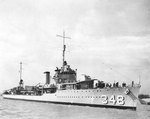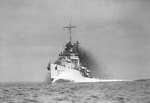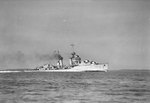Mark 12 5-inch/38 caliber Naval Gun
| Country of Origin | United States |
| Type | Naval Gun |
| Caliber | 127.000 mm |
| Length | 5.680 m |
| Barrel Length | 3.990 m |
| Weight | 1810.000 kg |
| Ammunition Weight | 24.94 kg |
| Rate of Fire | 15 rounds/min |
| Range | 16.459 km |
| Muzzle Velocity | 792 m/s |
Contributor: David Stubblebine
ww2dbaseThe 5-inch/38 caliber dual-purpose naval deck gun of the United States Navy was one of the most numerous models produced and among the most widely used throughout the fleet. According to the 1957 Naval Ordinance Manual, the 5-inch/38 caliber gun was unquestionably the finest dual-purpose naval gun of World War II.The reference "5-inch/38 caliber" signifies that the gun barrel has a 5-inch diameter (or caliber) and the barrel length is 38 calibers long, or 38 times the diameter. That works out to a barrel length of 190 inches, or 15 feet, 10 inches. The 5"/38 was developed as an intermediate gun between the 5"/51 surface-to-surface gun and the 5"/25 anti-aircraft gun. Except for the increased barrel length, the design of the 5"/38 gun itself was substantially similar to the earlier 5"/25 gun. The 5"/38 gun was developed in two types, the single-purpose gun that was limited to the surface-to-surface role and the dual-purpose gun that could also perform the anti-aircraft function. The single-purpose gun was limited to a maximum elevation of 35-degrees above the horizontal while the dual-purpose gun could be raised to 85-degrees.
The gun in its single-purpose design was originally intended in the early 1930s as the primary armament for new destroyer construction. The first ship fitted with the design was the USS Farragut, commissioned in 1934. Improvements were made to the gun mounts and the improved system first saw service on the destroyer USS Gridley, commissioned in 1937. With the development of the dual-purpose gun, the high rate of fire and its effective shell meant that the 5"/38 guns rapidly appeared on almost every US Navy warship from destroyer escorts to aircraft carriers. The guns were also fitted to many Coast Guard vessels and armed auxiliaries. The widespread distribution of the 5"/38 gun also made for standardized ammunition needs throughout the fleet, which had been heretofore unheard of for naval armaments and this streamlined the logistical flow enormously. Then, with the 1943 introduction of the proximity fuse for anti-aircraft artillery, the anti-aircraft effectiveness of the 5"/38 was increased sevenfold, according to the wartime Office of Scientific Research and Development. During early tests of the marriage of the 5"/38 shell and the proximity fuse in Aug 1942, the cruiser USS Cleveland was scheduled to conduct two days of testing against radio-controlled drone aircraft targets on Chesapeake Bay and the results exceeded all expectations.
As a surface-to-surface gun, the 5"/38 still packed a punch. It was capable of penetrating 5 inches of armor belt at 4,000 yards (but in naval terms, 4,000 yards is almost point-blank range compared to the 40,000-yard range of the USS Missouri’s 16-inch/50 caliber main guns or the 60,000-yard range of the battleship Bismarck’s 15-inch/48 caliber guns). In the surface-to-surface application, 5"/38 guns may have been better suited for shore bombardments against reinforced emplacements. It was destroyers firing 5"/38 guns, after all, that cracked the hardest points of the Atlantic Wall in direct support of the landing troops at Normandy.
Sometimes mounted on open pedestals, sometimes mounted within open-backed armor shields, and sometimes mounted inside full turrets, 5"/38 guns appeared in many ways on ships’ decks. Several classes of destroyers and destroyer escorts had the guns mounted singly within enclosed or semi-enclosed turrets while twin turrets were put aboard cruisers, battleships, and fleet carriers. The eight cruisers of the Atlanta-class had either six or eight twin 5"/38 turrets as their main guns rather than as secondary armament. This made them formidable anti-aircraft platforms and since the Atlanta-class was conceived prior to war breaking out when the battleship mentality still permeated the Navy, the creation of an almost single-purpose anti-aircraft cruiser was indeed farsighted.
Over 8,000 5-inch/38 caliber guns were produced between 1940 and 1945. Warships carried 2,168 guns mounted singly and 2,714 guns in twin mounts. An additional 3,298 guns were mounted singly aboard auxiliary ships and merchant vessels. The average cost per gun assembly was $100,000 and millions of rounds of ammunition for the 5"/38 guns were produced and expended. With many US Navy ships being sold to other nations after the war, the 5-inch/38 caliber guns saw world-wide service long after they left the US fleet.
Sources:
United States Navy
NavWeaps Naval Weapons and Technology
NavSource Naval History
San Francisco Maritime National Park Association
United States Naval Institute
The Pacific War Online Encyclopedia
Wikipedia ww2dbase
Last Major Revision: Apr 2021
Mark 12 5-inch/38 caliber Naval Gun Interactive Map
Photographs
 |  |  |  |
Mark 12 5-inch/38 caliber Timeline
| 30 Jun 1943 | While covering the landings on Rendova, Solomon Islands, destroyer USS Ralph Talbot engaged attacking Japanese Mitsubishi G3M 'Nell' bombers armed with torpedoes. Firing 5-inch shells fitted with VT proximity fuzes from her 5-inch/38 caliber guns, Ralph Talbot accounted for three bombers shot down on her own and one more shared with other ships. During the attack, one torpedo struck attack transport USS McCawley causing her to go dead in the water. Ralph Talbot came alongside and took aboard 300 McCawley officers and men. Three hours later, McCawley was sunk by torpedoes from US PT Boats. |
Please consider supporting us on Patreon. Even $1 per month will go a long way! Thank you. Please help us spread the word: Stay updated with WW2DB: |
Search WW2DB

News
- » Wreck of Teruzuki Found (27 Jul 2025)
- » USS Orlean's Bow Found (22 Jul 2025)
- » The Emperor of Japan Planned to Honor WW2-era Japanese POWs in Mongolia (4 Jul 2025)
- » US State Lawmaker John Winter Caught Using Racial Slur "Jap" and Apologized (11 Jun 2025)
- » US Government Plans to Purge WW2 Information (17 Mar 2025)
- » See all news
Mark 12 5-inch/38 caliber Naval Gun Photo Gallery
 |
Current Site Statistics
- » 1,182 biographies
- » 337 events
- » 45,119 timeline entries
- » 1,248 ships
- » 350 aircraft models
- » 207 vehicle models
- » 376 weapon models
- » 123 historical documents
- » 261 facilities
- » 470 book reviews
- » 28,410 photos
- » 365 maps
Famous WW2 Quote
"All that silly talk about the advance of science and such leaves me cold. Give me peace and a retarded science."Thomas Dodd, late 1945
Support Us
Please consider supporting us on Patreon. Even $1 a month will go a long way. Thank you!
Or, please support us by purchasing some WW2DB merchandise at TeeSpring, Thank you!